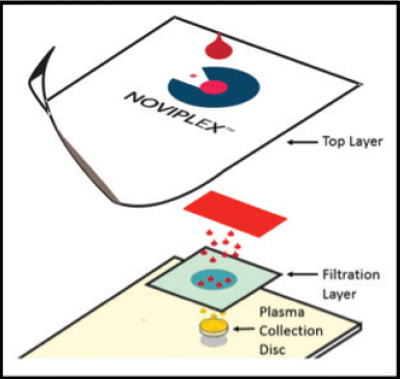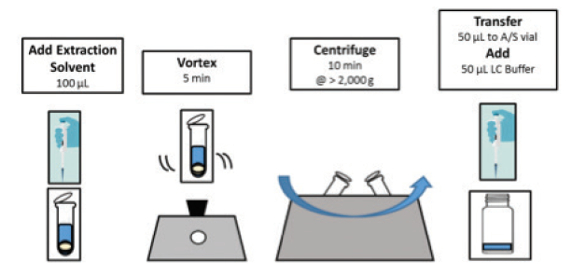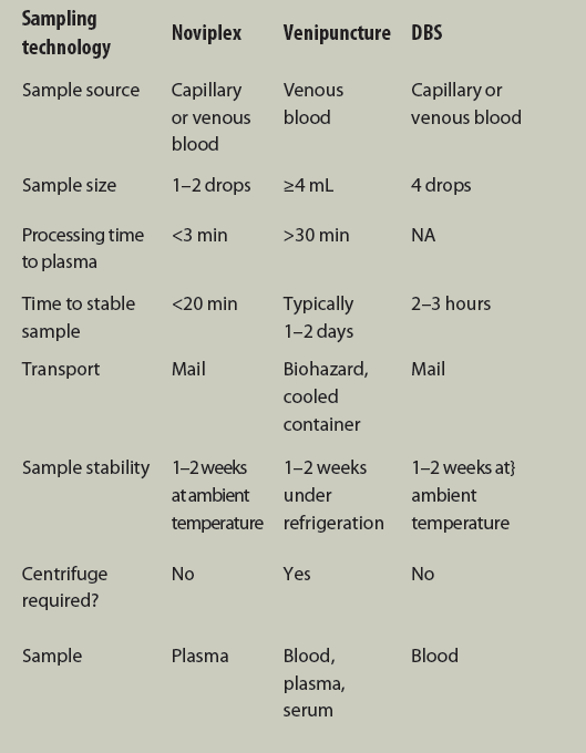Featured Article

RLS: Tim, I remember when we worked together on HPLC at Varian Associates in the early 1980s. As I recall, you earned your Ph.D. working for Professor Fred Regnier at Purdue University. Professor Regnier has started several companies, and Novilytic (West Lafayette, IN) is the latest. You are VP of Business Development for a potentially disruptive, card-based sampling technology. Please tell us more.
TS: Yes, Professor Regnier noted that despite the tremendous advances in instrumentation for analytics of blood samples, the sample acquisition and processing is “time tested,” which is another way of saying old and probably out of date. Becton Dickinson’s Vacutainer for venous blood samples dates from 1949, and dried blood spots (DBS) were introduced in 1963. Under Regnier’s leadership, Novilytic has combined the best of these sampling technologies to produce a card-based sampling system called Noviplex that we believe is a disruptive platform for quantitative assays of plasma samples starting with whole blood (Figure 1).
 Figure 1 – Noviplex cards consist of three layers: a top layer where blood is applied from a finger stick or pipette; a filtration layer that removes blood cells; and a collection layer that collects a fixed volume of plasma, typically 3 µL.
Figure 1 – Noviplex cards consist of three layers: a top layer where blood is applied from a finger stick or pipette; a filtration layer that removes blood cells; and a collection layer that collects a fixed volume of plasma, typically 3 µL.RLS: What are the benefits of using the Noviplex card compared to conventional venous blood-collection technology?
TS: The Noviplex technology offers several advantages compared to traditional venous blood draws. These benefits are important in daily operation in labs involved in both clinical diagnostics and clinical trials. Finger sticks or capillary blood draws are quick, easy, and pose less risks than phlebotomy.
Unlike blood collection in tubes, Noviplex cards quickly preserve the sample in a dry state where it is less susceptible to metabolism and uncontrolled environmental variables. Noviplex assays usually have %RSDs smaller than 10%, which compares favorably with RSDs for vacuum tube sample preparation. Also, blood tubes ship in biohazard containers because of the risks of infection, while Noviplex cards ship by standard mail.
RLS: Measuring concentration usually requires determining the amount of analyte in a specific, known volume. How does the card do this and how well?
TS: As shown in Figure 1, the card contains a sandwich of a size-selective filter on top of a disk of paper. When the blood sample sits on top of the filter, wicking action pulls the plasma through the filter and saturates the wicking disk. Blood is applied to the top layer, and gentle filtration produces plasma without breaking the red blood cells (RBCs). The sorption properties of the plasma-collection disk ensure a consistent volume of plasma. The Noviplex card is probably the first multilayer device for plasma preparation that employs vertical flow.
Now, how well does the volume control work? To measure the volume of plasma collected in each disk, three batches of six Noviplex cards were wetted with blood. The top layer was removed after 3 minutes, and the plasma collection disks were placed in a tared tube. Net weight of plasma was converted to a retained volume using the density of plasma (1.025 g/ mL) (Table 1). The Noviplex UNO collects 3 µL of plasma with a little variation from lot-to-lot.
Table 1 – Volumetric precision of plasma collection* 
*Plasma volume is determined with a microbalance using the known density of plasma (CV, also known as RSD).
RLS: What are examples of analytes suitable for a dried plasma card?
TS: If the analyte is soluble in plasma, it will pass through the filtration membrane and be collected on the disk. Successful samples include amino acids; small-molecule therapeutics, including vitamins, minerals, and hormones; and related metabolites, peptides, and even antibodies. We see Noviplex cards having potential applicability in almost all assays where plasma is the matrix of choice.
RLS: Can you describe the workflow from patient to results?
TS: The workflow is very simple, as shown in Figures 2 and 3. The card prepares the sample automatically. The user just needs to peel off the top layer containing the RBCs. Extraction is usually done with water and methanol. Extraction solvents that work for DBS usually work with the plasma collection disk. Vortex the disk with extraction solvent and then centrifuge to clarify the solution. Add an aliquot to an autosampler vial plus LC buffer to ensure a good LC separation.
 Figure 2 – Noviplex card use—apply a drop or two of blood to the target area, peel off the top layer after 2–3 minutes, dry for 15 minutes, and mail to the testing lab.
Figure 2 – Noviplex card use—apply a drop or two of blood to the target area, peel off the top layer after 2–3 minutes, dry for 15 minutes, and mail to the testing lab. Figure 3 – Analyte extraction for LC/MS—remove the plasma collection disk with tweezers or spatula; place in a 2-mL tube; add 100 µL of extraction solvent, usually methanol and water; vortex to extract the analyte(s) and
Figure 3 – Analyte extraction for LC/MS—remove the plasma collection disk with tweezers or spatula; place in a 2-mL tube; add 100 µL of extraction solvent, usually methanol and water; vortex to extract the analyte(s) and centrifuge
to clarify the solution; and place an aliquot in an autosampler vial and add LC buffer. The Noviplex sample is then ready for LC/MS.RLS: What happens at the analytical lab?
TS: The collection disk is removed from the card and placed in an extraction vial or a 96-well plate. An aliquot of extraction solution is added. After vortexing for a few minutes, an aliquot of the supernatant is transferred to an autosampler vial for analysis.
RLS: What about the limit of detection?
TS: The limit of detection is analyte- and detector-specific, but generally in the low nanogram per milliliter range. Of course, the analyte should be nonvolatile. Blood alcohols are out.
RLS: Can other body fluids be used?
TS: Yes, the disk format is quite flexible. It has even been used for drug analysis in urine. It has also been used with tissue homogenates for measuring heavy metals in specific fish organs.
RLS: Tell me more about the extraction solution.
TS: The extraction solution should be evaluated for analyte recovery for each assay. However, in practice, this is not difficult, since aqueous methanol is usually suitable. Usually extraction solvents that work with DBS cards will work with Noviplex cards. The disk is designed not to be a selective sorbent.
For method development, pipette a sample onto a blank Noviplex collection disk. Dry and then test the extraction solution for recovery by vortexing the extraction solution in a vial with a spotted collection disk. Then transfer an aliquot of the supernatant to the autosampler vial. Find a suitable extraction protocol for each analysis. This should be recorded as part of the method validation for the analyte and laboratory.
RLS: What if the detection limit is not sensitive enough?
TS: Some assays require larger amounts of plasma or an archived sample for legal purposes. The Noviplex DUO collects plasma on two disks, each with a 3-µL volume, from one application of blood. The disks can be combined in a single assay to produce 6 µL of plasma. Both disks have equivalent plasma volumes to within 5%. For example, we found that the Noviplex UNO disk gave a weak signal for a compound near its limit of detection, but switching to the Noviplex DUO and using both disks increased signal intensity about twofold and made the %RSD acceptable for bioanalysis.
RLS: When we started off, you said that Noviplex is a disruptive technology in blood sampling. What justifies “disruptive”?
TS: With Noviplex cards, one can prepare a stable plasma sample in a few minutes. This is at least five times faster than standard venipuncture. The most disruptive factor is that it enables blood samples to be collected anytime and anywhere. There is no need to travel from the doctor’s office to a blood collection center. Blood samples could be collected during a doctor’s visit. Table 2 compares venipuncture, DBS, and Noviplex cards.
Table 2 – Comparison of sampling blood using Noviplex cards, venipuncture, and DBS 
More than half of the plasma assays done in the U.S.A. involve a workflow where the blood is drawn and held for transport to a central laboratory where plasma is produced by centrifugation. During the time between blood collection and plasma generation, the concentration of analytes may change due to both enzymatic and chemical activity. Both Noviplex and DBS cards stabilize the sample quickly, but Noviplex is the fastest.
DBS and Noviplex cards are easy and safe to transport, because drying the sample inactivates bloodborne pathogens. In contrast, blood samples need to be shipped cold but not frozen. Freezing causes lysis of the RBCs, which interferes with many plasma assay protocols. Blood samples are refrigerated upon arrival. Blood samples should be processed quickly because they slowly degrade, even in the refrigerator. After two weeks, blood samples are no longer suitable for transfusion or many clinical assays.
RLS: Noviplex cards primarily use mass spectrometry for detection, but MS is expensive. How do the costs compare?
TS: We need to consider both cost and quality. Mass spec is the gold standard for small-molecule analysis, but the instruments were used mostly in research and were not approved for use in clinical labs. Recently, the FDA approved a test for Vitamin D using mass spec. Cost comes into play because the mass spec labs are usually far away, and overnight shipping of blood samples in biohazard containers is required. Medicare has set a price of about $40 for a Vitamin D test and that barely covers the cost of shipping samples. Noviplex cards enable samples to ship by standard mail for a few dollars. The ability to ship stable plasma cross country by standard mail is a game-changer for mass spec.
RLS: I can see why the Novilytic staff is optimistic about the future of the plasma card. The extension to other fluids such as urine is exciting.
Robert L. Stevenson, Ph.D., is Editor Emeritus, American Laboratory/ Labcompare; e-mail: [email protected]